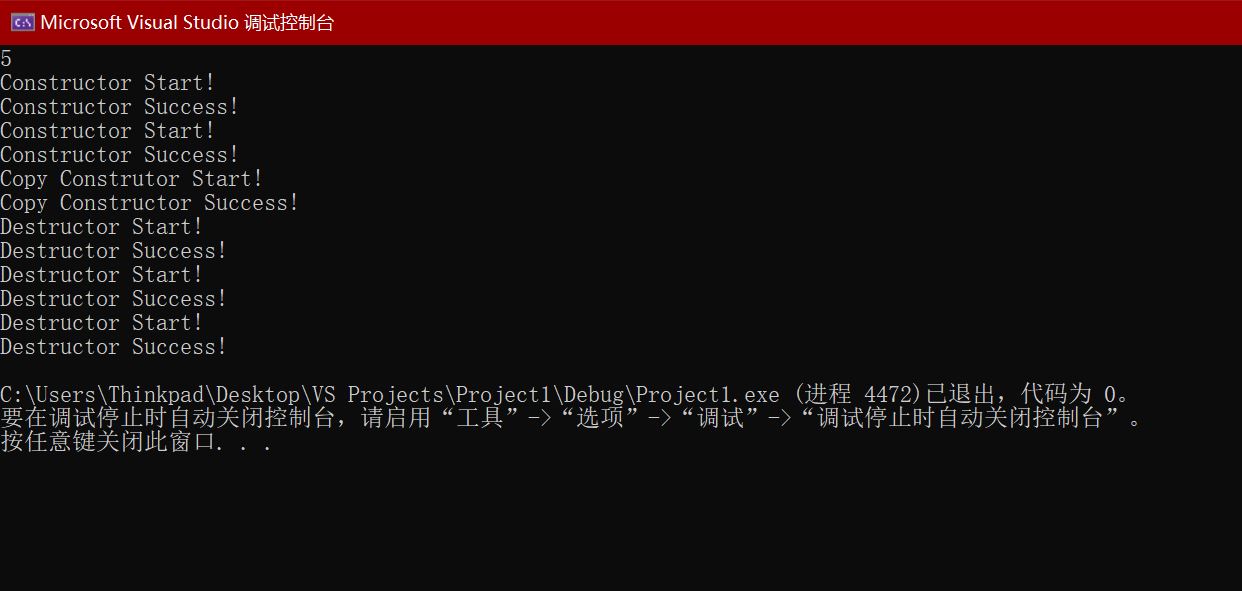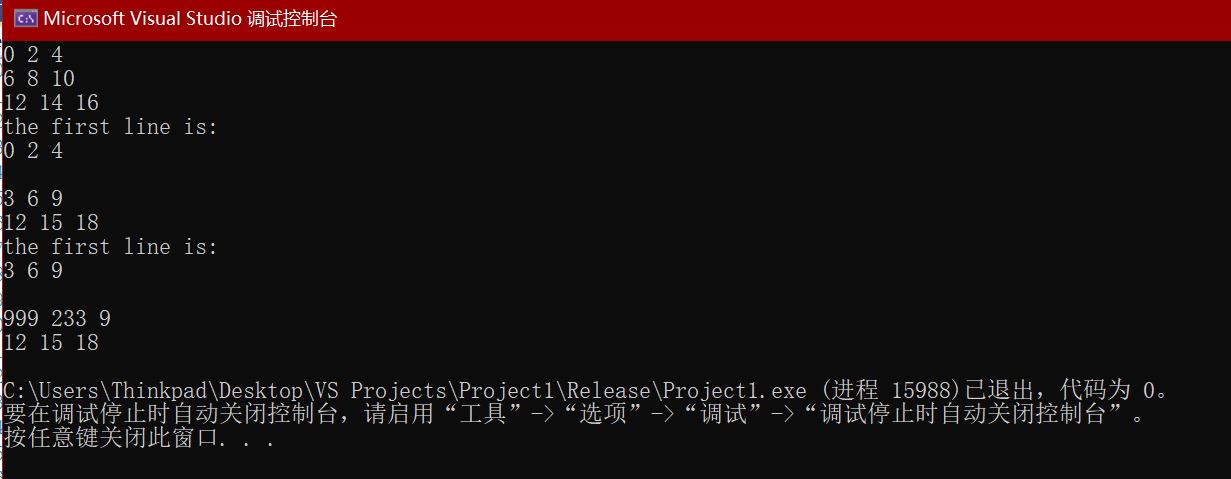T1:
vector_int.hpp
1 #include<iostream> 2 using namespace std; 3 class Vector_int { 4 public: 5 Vector_int(int n); 6 Vector_int(int n, int value); 7 Vector_int(Vector_int& x); 8 int& at(int i); 9 ~Vector_int() { 10 cout << "Destructor Start!" << endl; 11 delete[] vec; 12 cout << "Destructor Success!" << endl; 13 } 14 private: 15 int* vec; 16 int size; 17 }; 18 Vector_int::Vector_int(int n) { 19 cout << "Constructor Start!" << endl; 20 vec = new int[n]; 21 size = n; 22 cout << "Constructor Success!" << endl; 23 } 24 Vector_int::Vector_int(int n, int value) { 25 cout << "Constructor Start!" << endl; 26 vec = new int[n]; 27 for (int i = 0; i < n; i++) 28 vec[i] = value; 29 size = n; 30 cout << "Constructor Success!" << endl; 31 } 32 Vector_int::Vector_int(Vector_int& x) { 33 cout << "Copy Construtor Start!" << endl; 34 vec = new int[x.size]; 35 size = x.size; 36 for (int i = 0; i < size; i++) 37 vec[i] = x.vec[i]; 38 cout << "Copy Constructor Success!" << endl; 39 } 40 int& Vector_int::at(int i) { 41 if (i < size && i>=0) 42 return vec[i]; 43 }
vector_int.cpp
1 #include"vector_int.hpp" 2 #include<iostream> 3 using namespace std; 4 int main() { 5 int n; 6 cin >> n; 7 Vector_int x(n); 8 Vector_int y(n, 1); 9 Vector_int z(y); 10 z.at(2) = 0; 11 }

T2:
Matrix.hpp
1 #ifndef MATRIX_H 2 #define MATRIX_H 3 4 #include <iostream> 5 #include <cassert> 6 7 class Matrix 8 { 9 public: 10 Matrix(int n); // 构造函数,构造一个n*n的矩阵 11 Matrix(int n, int m); // 构造函数,构造一个n*m的矩阵 12 Matrix(const Matrix &X); // 复制构造函数,使用已有的矩阵X构造 13 ~Matrix(); //析构函数 14 void set(const double *pvalue); // 用pvalue指向的连续内存块数据为矩阵赋值 15 void set(int i, int j, int value); //设置矩阵第i行第j列元素值为value 16 double &at(int i, int j); //返回矩阵第i行第j列元素的引用 17 double at(int i, int j) const; // 返回矩阵第i行第j列元素的值 18 int get_lines() const; //返回矩阵行数 19 int get_cols() const; //返回矩列数 20 void print() const; // 按行打印输出矩阵 21 private: 22 int lines; // 矩阵行数 23 int cols; // 矩阵列数 24 double *p; // 指向存放矩阵数据的内存块的首地址 25 }; 26 27 Matrix::Matrix(int n) { 28 lines = n; 29 cols = n; 30 p = new double[n*n]; 31 } 32 Matrix::Matrix(int n, int m) { 33 lines = n; 34 cols = m; 35 p = new double[n * m]; 36 } 37 Matrix::Matrix(const Matrix& X) { 38 lines = X.lines; 39 cols = X.cols; 40 p = new double[lines * cols]; 41 for (auto i = 0; i < lines * cols; i++) { 42 p[i] = X.p[i]; 43 } 44 } 45 Matrix::~Matrix() { 46 delete[] p; 47 } 48 void Matrix::set(const double* pvalue) { 49 for (int i = 0; i < lines * cols; i++) { 50 p[i] = pvalue[i]; 51 } 52 } 53 void Matrix::set(int i, int j, int value) { 54 p[i * cols + j] = value; 55 } 56 double& Matrix::at(int i, int j){ 57 return p[i * cols + j]; 58 } 59 double Matrix::at(int i, int j) const { 60 return p[i * cols + j]; 61 } 62 int Matrix::get_lines() const { 63 return lines; 64 } 65 int Matrix::get_cols() const { 66 return cols; 67 } 68 void Matrix::print() const { 69 for (int i = 0; i < lines; i++) { 70 for (int j = 0; j < cols; j++) { 71 std::cout << p[i * cols + j]<<" "; 72 } 73 std::cout << std::endl; 74 } 75 } 76 #endif
Matrix.cpp
1 #include <iostream> 2 #include "Matrix.hpp" 3 4 int main() 5 { 6 using namespace std; 7 8 double x[] = {0,2,4,6,8,10,12,14,16}; 9 double x2[] = { 3,6,9,12,15,18 }; 10 Matrix m1(3); // 创建一个3×3的矩阵 11 m1.set(x); // 用一维数组x的值按行为矩阵m1赋值 12 m1.print(); // 打印矩阵m1的值 13 cout << "the first line is: " << endl; 14 cout << m1.at(0,0) << " " << m1.at(0,1) << " "<< m1.at(0,2) << endl; 15 cout << endl; 16 17 Matrix m2(2, 3); 18 m2.set(x2); 19 m2.print(); 20 cout << "the first line is: " << endl; 21 cout << m2.at(0,0) << " " << m2.at(0,1) << " " << m2.at(0,2) << endl; 22 cout << endl; 23 24 Matrix m3(m2); 25 m3.set(0, 0, 999); 26 m3.at(0, 1) = 233; 27 m3.print(); 28 }




